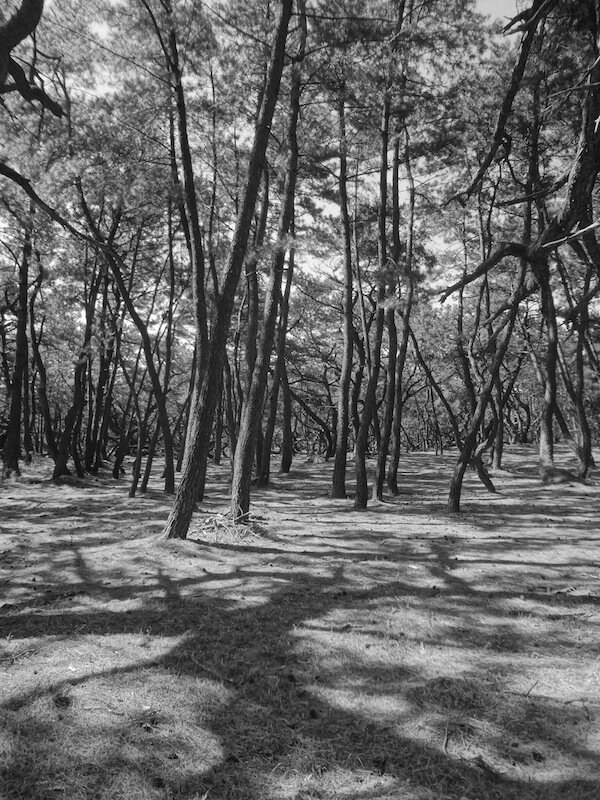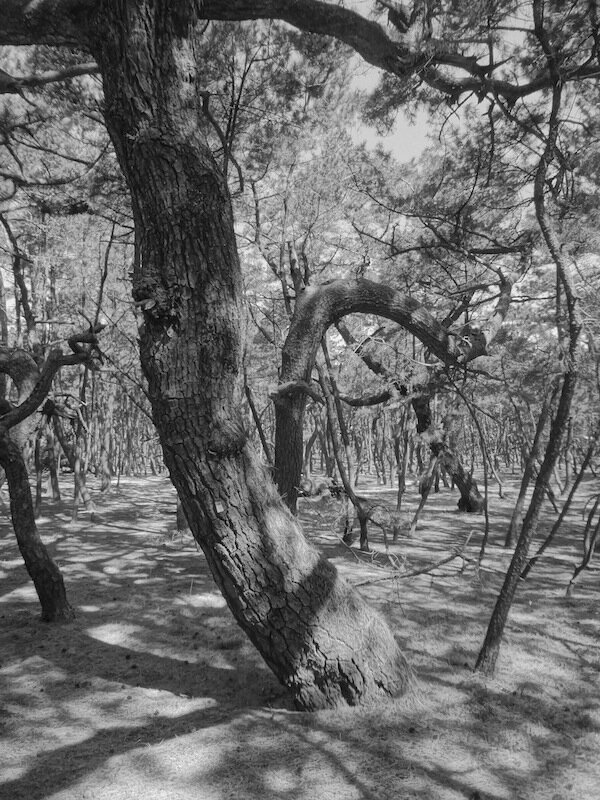There are two main approaches to Karatsu City (Saga) from Fukuoka. One is the faster, less scenic Route 202 that takes you to the south of the city, the other is a two-lane artery through the twisted sinews of a thick pine forest stretching for almost five kilometers along the Hamasaki and Kagami coastline. The forest, named Niji no Matsubara (虹の松原, lit. “Rainbow Pine Grove) is more eerie looking than its sunny name implies and you really wouldn’t want to walk through it alone early in the morning like I did a few years back to take these photos.
The forest was planted in the early 17th century to block the wind from the sea upon instructions of the lord of the Karatsu Han (domain). At the time, the forest was called Niri Matsubara (二里松原, llt. “Two Ri Pine Grove”, where one ri is equal to about 3.9km). The present name Niji no Matsubara has its roots in the original name, but it is uncertain how the change in pronunciation came about. The use of 虹 (rainbow) in the name dates back to 1771. In the early Meiji Period the forest was designated as a National Forest and protected. There are more than 1 million Kuromatsu (黒松, Japanese Black Pine) in the forest today.
忠霊碑 (Chūreihi)
A monument dedicated to “the loyal dead”, namely those who died for the country.
This is a good chance to talk a little about the ri (里), which is a traditional Chinese unit of distance, equivalent to 3.9 kilometers in length in Japan. The Chinese li has varied in length from region to region and over time, but today it has been standardized at 500m. In Korea the ri is about 400m in length.
In ancient times the ri was equivalent to 5 chō (町) or 300 steps and slightly longer (533.5m) than the ri that is still in use today in Japan.
The Shakkanhō (尺貫法) or traditional system of measurements was introduced to Japan from the Tang Dynasty in 701.
The base unit of length is the shaku (尺), which is based on the Chinese chi and was taken from the span of the end of the thumb to the outstretched middle finger. Over time the distance of the shaku increased and today is 33 centimeters long. There are different kinds of shaku for different uses, such as carpentry (曲尺, kanejaku) and tailoring (呉服尺, gofukujaku), but let’s not get into that right now.
One Japanese ri (里) is equivalent to 12,960 shaku (or 3.927 km) today, which is much longer than the Chinese or Korean equivalents. The ri can also be divided into 36 chō or 2,160 ken (間).
1 ri (里) = 12,960 shaku or 3.927 km
1 chō (町) = 360 shaku or 109. m
1 jō (丈) = 10 shaku or 3.030m.
1 shaku (尺) = 30.30 cm
1 ken (間) = 1.818m or 6 shaku.
1 sun (寸) = 3.030 cm
1 bu (分) = 3.030 mm
There are even smaller units but their usefulness are negligible.









